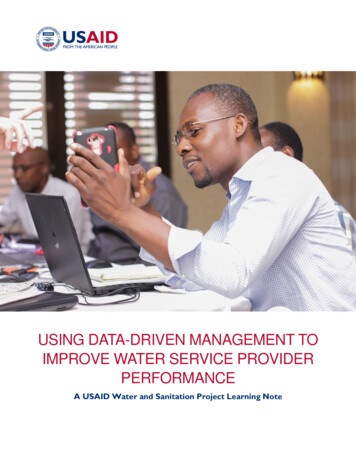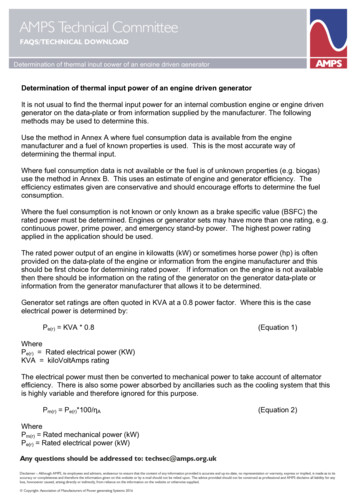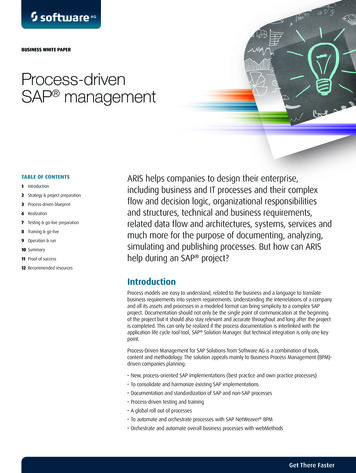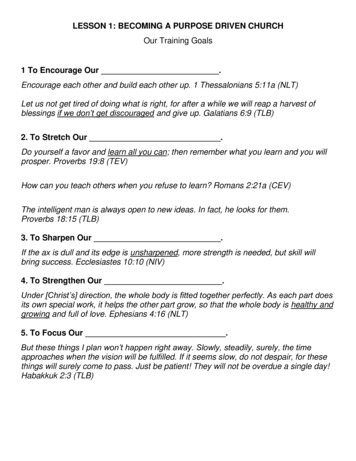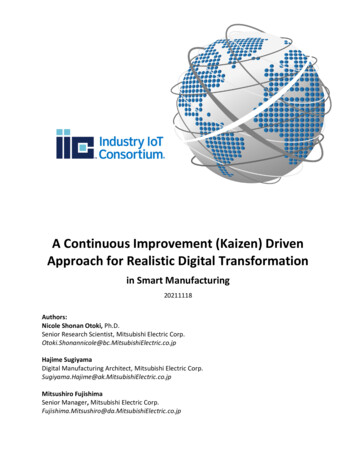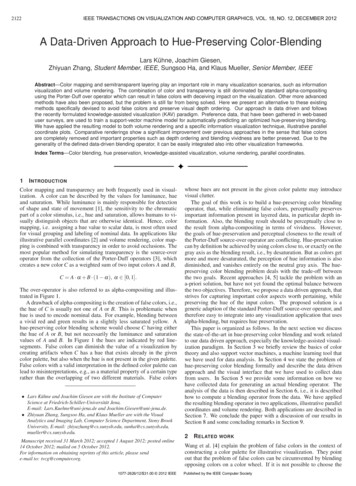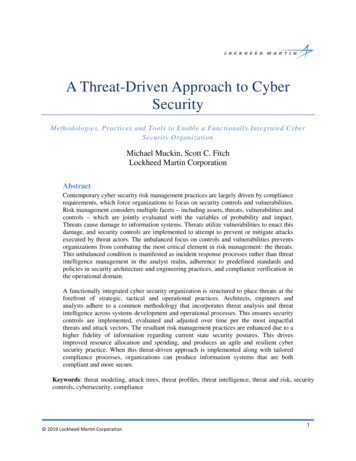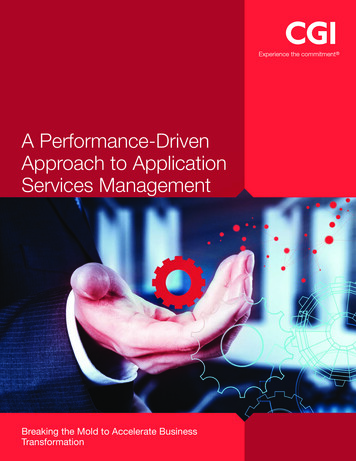
Transcription
A Performance-DrivenApproach to ApplicationServices ManagementBreaking the Mold to Accelerate BusinessTransformation
Table of contents1.0 The “keep up” versus “step up” challenge. 12.0 Taking a different approach to application services management.23.0 The fundamentals of a performance-driven approach.34.0 Transitioning to a performance-based model.45.0. Conclusion.5
cgi.com1.0 The “keep up” versus “stepup” challengeIn the digital world, organizations of all types and sizes arereevaluating their strategies, business models, processesand systems to discover new ways to drive transformationand performance through advancing technologies such ascloud, Internet of Things, big data, mobility, cybersecurityand more. Digital technologies like these are revolutionizinghow organizations operate, how they interact and servetheir customers/citizens, and the kinds of products andservices they deliver, opening the door to new revenuestreams, improved efficiencies, increased customer loyaltyand greater differentiation in the market. Investing inthese technologies is no longer an option, but a businessimperative to stay competitive in the 21st century.A major challenge all organizations are facing on thepath to digitalization is balancing the need for investingin transformative technologies and programs—i.e.,“step up” activities—with the need to maintain theday-to-day “keep up” activities critical to running theirbusiness. Some also use the terms “run the business”versus “change the business,” or “bi-modal IT,” butregardless of the terminology used, the challenge is thesame—organizations are finding it difficult to find fundsfor accelerating business transformation due to revenuestagnation, tight budgets and increasing regulation.Every year, as part of CGI’s Voice of Our Clients program,we conduct in-depth, face-to-face interviews with clientexecutives across the industries we serve to get a pulseon the trends impacting their organizations, the businessimplications of those trends, and their resulting top ITpriorities. In 2015, we interviewed 965 executives—44percent from the business side and 56 percent from IT—across 10 industries and 17 countries.1The results show that while digital transformation andthe IT investments required for it are top of mind forexecutives, there is increasing tension in achieving theright balance between activities that run the business andthose that change it. Executives are seeking to invest inthe following: IT modernization to drive agility and businesstransformation Big data and digital insight to improve the customerexperience Supply chain optimization to digitally connect allstakeholders across the enterprise Enhanced cybersecurity to protect stakeholders New delivery models, including SaaS, cloud, managedservices/outsourcing, etc., to align revenue and costs IT human capital to attract and retain the talentrequired to manage the strategic and executionaspects of the organizationHowever, they are struggling to make the necessaryinvestments to transform the business while at the sametime maintaining existing mature, complex and integratedIT platforms. On average, 82 percent of IT budgets areallocated to the mandatory operations needed to run thebusiness, leaving only 18 percent for changing the business.In addition, most of the executives we interviewed indicatedpressures to attract new talent for implementing newplatforms and digitizing processes while also retaining thetalent required to maintain legacy platforms. Further, thespeed at which businesses would like to invest and transformto meet evolving demands is also significantly reduced due tothe lack of flexibility in modernizing legacy technology.To step up to these demands to transform the organization,leading executives are looking into new options forreallocating IT spend and freeing up money for digitaltransformation investments. One such option is in the area ofapplication services (AS) management.While AS covers both “keep up” and “step up” activities,the “keep up” side of AS takes a significant share of theIT budget. By reevaluating how AS management is doneand implementing a new approach focused more onperformance and outcomes than resources, organizationscan drive significant cost savings that can then be divertedto “step up” investments that dramatically increasecompetitiveness and drive growth.
cgi.com2.0 Taking a different approach toapplication services managementTraditional approaches to AS management are insufficientto address the “keep up” versus “step up” challenge dueto a number of shortfalls. One of the major shortfalls istheir focus on input rather than output. When it comesto managing their applications, many organizationsconcentrate on staff—the number of people required toperform daily tasks—rather than on staff output. Focusingon staff leaves organizations without a clear picture of thefollowing:2The hallmark of a performance-based approach to ASmanagement is the use of predictive analytics and otherteam behaviorial techniques to generate a continuousflow of improvement ideas from AS team members.Through these techniques, team members receive detaileddata on their AS activities (e.g., effort and volume data)and use this data to generate metrics (e.g., effort, cost,variance, volume, FTC, etc.). Data and metrics are thenshared team-wide through regular meetings to driveimprovements in terms of the following: Better project and risk management Costs per application versus the value each applicationgeneratesGreater team collaboration through continuous sharingand learning, which leads to improved team skills Strong governance Business justifications for each application Increased efficiencies What applications people are working on Improved quality Day-to-day activities of team members Higher reusability Level of effort team members are putting forth Business process alignment Results delivered Proactive issue resolution Predictive modeling Reduced rework Desired business results This lack of transparency makes it difficult to find waysto improve and reduce costs. As a result, organizationsoften invest more money into AS than they need to withoutthe expected return. In addition, the money poured into“keep up” activities like AS means less money for “step up”investment, the driver for incremental business value.Focusing on output provides the necessary transparencyfor driving ongoing improvements and cost savings. Itenables an organization to better understand the purposeof each application, its usage, and the value it brings tothe business. Organizations gain clear insight into costs,staff, licenses, hardware, overhead, historic data, etc.Overall, they benefit from a clear, end-to-end view of boththe cost and value creation involved with each application,which can be used to implement improvements asneeded.An output, performance-based approach to ASmanagement overcomes the shortfalls of traditionalapproaches by offering the following: Strong business focus (an organization’s businessobjectives and desired outcomes are addressed) Strong focus on continuous improvement Expected outcomes (in terms of driving quality,operational excellence, security, incremental value,innovation and business value) High-level of collaboration, resulting in long-termpartnerships based on mutual trust and acting as onebetween the organization and AS providerThis type of performance-based culture is based on twokey principles: What gets measured gets managed and improved Putting data in the hands of those closest to the workwill yield rapid improvementsAs data becomes a natural part of the work of AS teammembers, it becomes a strong motivator for performanceand innovation. Team members become more productive,proactive, agile, enterpreneurial and collaborative. Theylook for ways to drive operational excellence andincremental value. They also experience higher levelsof work satisfaction as they reap the rewards of theirmeasured efforts and outcomes.
cgi.com3.0 The fundamentals of aperformance-driven approachThe fundamentals of performance-based approach to ASmanagement include the following: Team management Metrics and performance management Quality management and testing Cost management Knowledge management GovernanceEach area involves well-defined objectives and processesthat guide the overall AS management program, ensuringachievement of the organization’s strategic goals and ahigh return on investment.Team managementWhile data, metrics and processes are important factorsin a performance-driven AS approach, the human factorby far exceeds them all. People drive performance, andpeople are at the heart of a performance, output-basedapproach. As such, team management is central at boththe management and operational levels.At the management level, governance metrics ensurethat members are empowered to do their jobs, that theright processes are used, and that metrics reportingand analysis is performed. This is how the teams gaininsight into the level of quality they are delivering and howto improve quality even further. At the operational level,team management spans the entire set of AS processes,allowing data to be used and shared by teams to optimizeresource assignments, identify improvement opportunitiesand drive cost savings. As noted previously, putting datain the hands of those closest to the work will yield rapidimprovements.Close to real-time optimization of specific AS activityassignments is enabled through daily reporting andanalysis of team member cost and time expenditure data.Metrics and performance managementThe second most fundamental aspect of a performancedriven AS approach is a focus on metrics, both contractualand team-driven, and performance management. Teammembers apply AS performance management techniquesto gather and analyze data on their daily work activities.Through this, they gain an understanding of the tangiblecost or effort for specific work outcomes, such as incidentor service request resolutions.3This data and analysis, in turn, enables them to establisha performance baseline and set performance thresholdsas part of a continuous, iterative cycle of measurementand improvement. With a better understanding of theirperformance, team members can recalibrate their workas required. Certain data allows for fine tuning andimprovement of operational processes in very short timeframes, sometimes as quickly as in a day. For example,at a morning team meeting, based on the daily keyperformance indicator (KPI) report, the team might decideto distribute the work differently this day, with the results tobe evaluated the following day.In addition to supporting improvement initiatives, theperformance data also has significant value as historicaljustification for future projects and innovation. In addition,historic data can be leveraged for other internal sharingand benchmarking purposes.Quality management and testingAnother key aspect of a performance-based AS approachis that it provides defect metrics for measuring quality. Thesemetrics enable team members to understand the level ofquality attainable and the level of quality they are delivering.As a result, they can better identify and correct defects andimplement preventive actions as part of an overall qualitymanagement program, instead of simply handling one-offticket incidences.In addition, defect metrics support application testing,security and change management within large andcomplex application portfolios, as well as predictivetechniques, which enable the implementation of risk plansand mitigation strategies based on specific inputs.Cost managementTraditional AS approaches focus on cost management asa standalone. Performance-driven approaches combinecost and performance management to ensure that whencosts are reduced, quality and outcomes are not impacted.Key performance indicators and cost metrics are verymuch interlinked.As a by-product of performance management, operationalteams learn through metrics the direct relationshipbetween cost and their work activities and gain anunderstanding of how they can drive business value byimproving the cost basis of these activities.Once cost metrics are under control and a stable historyof data is available, it becomes possible to forecast theprecise cost of specific development or maintenanceactivities. A global data set allows the team to understandthe cost implications of using global delivery versus theneed for client intimacy through geographic proximity.Continual tracking of cost estimates versus actual costsleads to ongoing cost and planning improvements.
cgi.comKnowledge managementKnowledge management is a discipline that allows forthe capture of vital corporate information and makes itavailable to the right person at the right time to assist indecision-making. With a performance-driven AS approach,knowledge management is integrated across all AS areasand processes. Team members are provided not only withtools and continuous coaching to help them store andshare knowledge, but also are responsible for tracking thetime and effort spent on knowledge management.Effective knowledge management enables AS teammembers to commit ideas to corporate memory, afundamental exercise for a performance-based, learningorganization. This results in improved service quality andefficiency through quick global access to informationand solutions. It also ensures that when a team memberleaves, knowledge is still available, both in the form ofdocumentation and among remaining team members.GovernanceGovernance is both a top down and bottom up approach witha performance-driven AS approach. Every month the mostrelevant KPIs are aggregated and presented by the local CGIclient account executive to the client’s senior management toprovide a performance overview for the entire organization.Rigorous governance processes also drive and facilitateclose collaboration between management and teammembers. Typical management roles include a projectteam leader, a project manager, a program manager anda client account or delivery manager.Meetings are held on a daily, weekly and monthly basisamong these different managers to ensure close alignment,effective oversight and fast issue identification andresolution. Information shared and decisions made duringthe meetings are reported back to team members, as wellas the local CGI client account executive, who, in turn,reports back to the client’s senior management.Daily morning meetings also are held by project team leaderswith their teams. These meetings help to align team membersto common goals, foster transparency and knowledge sharing,and promote team spirit and collaboration.Each meeting is highly structured, brief and consistently heldto ensure meeting objectives are achieved and continuousimprovements are delivered across project teams.44.0 Transitioning to aperformance-based modelTransitioning to a performance-based AS model involvesboth cultural and operational change. Changing froman input-based culture to one focused on performancemanagement requires executive buy-in and oversight. Itstarts with executive-level understanding of the benefitsand executive-level participation in the governance. Onceexecutives are convinced of the value and committed toimplementation, the operational change can take place.At the operational level, a well-defined implementationprocess supported by training and coaching ensuresa structured and consistent implementation approach.Change management is a key focus. Processes aloneare insufficient to ensure success. Change managementprinciples and practices should be adopted that carefullyguide management and staff into new ways of thinkingand working that drive the benefits promised by this newapproach to AS management.Key operational transition steps include the following:Step 1: KPI definition Define business objectives Define all relevant KPIs Establish performance standards Identify data points and process flowsStep 2: Process development Understand data points in line with KPIs Develop performance management processes Develop report generation and circulation processesfor project, team and management levels Develop documentation processes Set up governance modelStep 3: Quality assurance implementation Develop quality audit template Design and implement standard QA processes Implement individual feedback and review mechanism
cgi.comStep 4: Execution of new AS approach Implement single and standardized performancemanagement system and processes Implement people management processes Implement continuous improvement process withmilestones Analyze and report on overall performance Conduct periodic reviews of processesOverall program management is handled at the globallevel. This level of management ensures the availability ofall necessary tools and resources, as well as collaborationamong all transformation leaders, including knowledgetransfer and coaching.5.0ConclusionMoving away from traditional AS management approachesto a performance-driven approach significantly improvesAS management and its outcomes, and generates costsavings that can be invested in business transformationand growth. Such an approach turns AS managementfrom an overhead cost into a real strategic driver. We areso convinced of the success of this approach that we canoffer your organization a proof-of-concept, trial run whereyou identify the team, and we provide the processes, bestpractices and coaching. Contact us at info@cgi.com tolearn more.We also invite you to explore the capabilities, processesand benefits of a performance-driven AS management byreading about CGI’s ProAction-AS approach.5About CGIFounded in 1976, CGI is a global IT and businessprocess services provider delivering high-quality businessconsulting, systems integration and managed services.Serving clients from 400 locations worldwide, CGI has anindustry-leading track record of delivering 95 percent ofprojects on time and within budget, aligning our teamswith clients’ business strategies to achieve top-to-bottomline results.CGI’s application services—including applicationdevelopment, management, testing, portfolio managementand modernization—enable clients to drive business agility,transformation and cost efficiencies. Our end-to-endservices provide the technology and industry expertise,solutions, skills, frameworks and processes our clientsneed to successfully build, run and evolve their enterpriseapplications.In addition, CGI’s proven application managementapproach delivers strong governance, collaboration,performance management and quality assurance—allthrough a flexible delivery model—to ensure expectedbusiness outcomes.
cgi.com
Metrics and performance management The second most fundamental aspect of a performance-driven AS approach is a focus on metrics, both contractual and team-driven, and performance management. Team members apply AS performance management techniques to gather and analyze data on their daily work activities.
